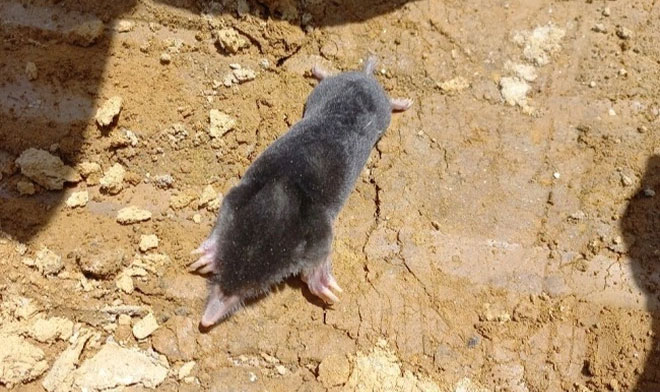The mole species discovered in Ngọc Linh Mountain (Kon Tum) and the Central Truong Son area is comparable in size to the Vietnamese mole, but significantly smaller than the Pakho mole.
Scientists from the Vietnam Natural Museum, Kyoto University, the National Museum of Nature and Science in Japan, and the Institute of Ecology and Biological Resources have recently identified a new mole species, temporarily named Ngọc Linh Mole (Euroscaptor ngoclinhensis), found in Ngọc Linh Mountain (Kon Tum) and the Central Truong Son region.
This finding results from comparing the differences between populations of the Small-toothed Mole (Euroscaptor parvidens) found in the Central Truong Son area (Kon Tum Plateau, Măng Đen, Kon Hà Nừng, and Pleiku) and the Southern Truong Son (M’Đrắk Plateau, Đắk Lắk, Mơ Nông, Lâm Viên, and Di Linh).

Ngọc Linh mole newly discovered in Vietnam.
It is known that the research also relied on multivariate statistical analysis of 140 mole specimens collected from 18 different sites, most of which belong to four species of the Euroscaptor genus found in Vietnam. This includes specimens collected from Chư Yang Sin National Park (Đắk Lắk) and Nam Nung Nature Reserve (Đắk Nông).
The average length of the Ngọc Linh mole ranges from 12.0 to 12.3 cm, with a tail length of about 1.5 cm, accounting for only 5.8 to 6.1% of the body length. This species is comparable in size to the Vietnamese mole (Euroscaptor subanura) but is significantly smaller than the Pakho mole (Euroscaptor parvidens).
Combining genetic factors and the geological uplift process of the two plateaus, the study hypothesizes that the ancestors of the species in the Small-toothed mole group and the Ngọc Linh mole were widely distributed in the Central and Central Highlands regions. Specifically, the Small-toothed mole is determined to be exclusively distributed in the Southern Truong Son area.
Subsequently, along with the geological uplift process of the Central Truong Son and Southern Truong Son plateaus, the formation of two subspecies (or species) began to occur during the Middle Miocene and continues to this day.
Most species in the mole family move by completely burrowing underground (fossorial). Adapted to this lifestyle, they have thick, elongated bodies, dark brown or dark gray soft fur, and most have orange or light-colored chest fur due to glandular secretion, with small ears, often lacking pinnae, and very small eyes that are nearly vestigial.
The forelimbs of the mole have developed to meet the digging needs with wide, outward-facing feet that can move backward, and large claws. In contrast, their hind limbs do not show much adaptation like the forelimbs. Moles primarily feed on earthworms, various insects, and larvae found underground.


















































